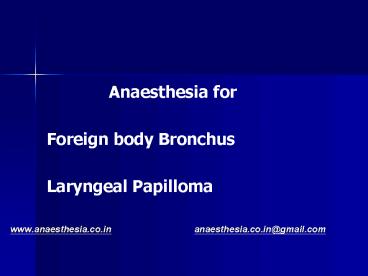Anaesthesia for PowerPoint PPT Presentation
1 / 37
Title: Anaesthesia for
1
- Anaesthesia for
- Foreign body Bronchus
- Laryngeal Papilloma
www.anaesthesia.co.in anaesthesia.co.in_at_gmail.c
om
2
Bronchoscopy
- Indication
- Foreign body evaluation/management
- Stridor
- Evaluation of laryngo tracheal pathology
- Management of airway mass
3
Goals during bronchoscopy
- Control of the airway
- Prevent or decrease airway and adrenergic
reflexes - Immobile surgical field
- Amnesia
- Smooth emergence and safe extubation
4
Flexible VS Rigid Bronchoscopy
- Selection depends on physician expertise
- Rigid bronchoscopy preferred technique
- Better ventilation and visualization,
suctioning, and control of bleeding - Flexible bronchoscopy- nonradiopaque peripheral
FB - lack of airway control ventilatory capacity
- Limited suction and instrumentation
5
(No Transcript)
6
Foreign body bronchus
- Most common 1-3 yrs
- 95 - right main bronchus
- 5 - trachea
- Laryngeal FB with complete obstruction is rare
- Types FB Organic - seeds, nuts
- Inorganic - coins,
needles, pins
7
- Clinical presentation
- H/o aspiration choking
- Bronchus
- Cough, Wheezing
- Tracheal or Laryngeal
- Cough, Dyspnea, Stridor, Cyanosis
- Secondary late symptoms
8
- Examination should focus
- Location
- Degree of obstruction
- Gas exchange
- Secondary pathological changes
9
Differential diagnosis
- Reactive airway disease
- Pneumonia, Empyema, croup,
- Tracheo bronchial tumor
- Tracheo bronchomalacia
- psychogenic cough
10
(No Transcript)
11
12
Anaesthetic management
- Pts condition determines the timing of
bronchoscopy - Depends on Level, Degree Duration.
- Induction
- Inhalational
IV - FB with stridor
peripheral FB - Laryngeal FB
13
Sevoflurane or Halothane?
- Sevoflurane Halothane
- More pleasant More soluble
- Rapid induction Slower elimination
airway manipulation - ? Minute ventilation Smooth post
anesthetic period - ? Diaphragmatic contractility
- Post op delirium ACNA 2001, Br
J Anes 76767-771,1996
14
- Total intravenous technique
- Propofol
- Bolus 2-3 mg/kg - 200 - 400mcg/kg/min
- Steady level of anaesthesia regardless of
ventilation and perfusion mismatch - Less airway irritability and emergence delirium
15
- Analgesia
- Fentanyl 1-2 mcg/kg
- Remifentanil 0.2-0.5 mcg/kg/min
- Topical analgesia lidocaine 3 4 mg/kg
- Muscle relaxant
- Succinylcholine
- Mivacurium, atracurium and vecuronium
16
Spontaneous VS controlled ventilation
Spontaneous
- Disadvantage
- Increased CO2
- Hard to GUARANTEE no movement
- Prolonged emergence
- Advantage
- Better ventilation
- Suspected Foreign body
- NMB partially compromised airway in to complete
obstruction
17
Controlled
ventilation
- Advantage
- Patient immobility
- More rapid emergence
- Better for hypercarbia
- Disadvantage
- Force the FB deeper
18
- Kosloske. AM Am J Dis Child. 198213610924-7
- Ronald S. Anesth Analg 2000911389-91
- Verghese. ACNA 2001
- Pawar DK. Paediatr Anaesth 200010333
19
- Techniques for ventilation
- Conventional ventilation
- Apnoeic oxygenation
- High frequency jet ventilator
20
Monitoring
- Standard monitoring
- Clinical vigilance is key
- Communication between the endocopist and
anaesthesiologist is important - Endtidal CO2 unreliable
21
Intraoperarive complication
- Acute airway obstruction
- Laryngo spasm and laryngeal edema
- Pneumomediastinum
- Pneumothorax
- Massive hemoptysis
22
- Tracheal intubation
- Tracheobronchial suction
- Lung expansion
- For oxygenation and ventilation
auscultation - Airway edema
- Dexamethasone (0.4 to 1 mg/kg )
- Racemic epinephrine (0.5ml -2.25)
- Monitor in the PACU
23
Laryngeal papillomatosis
- Recurrent Respiratory Papillomatosis (RRP)
- HPV-6 and HPV-11
- More common in children than adults
- Course of RRP is unpredictable
- Larynx is the most common site
24
- Hoarseness is the most common
- Choking episodes
- Cough, Dyspnea Inspiratory wheeze
- Stridor
- Respiratory distress
25
- Diagnosis
- Laryngoscopy or Bronchoscopy
- Imaging Studies
- X-ray
- CT scan
26
(No Transcript)
27
(No Transcript)
28
- No curative treatment
- Medical Surgical
- Interferon alfa-2a Forceps
- Acyclovir Ultrasonic
microdebrider - Indole 3-carbinol Laser
29
- Check previous medical records
- Premedication
- Quite anxious PAC help allay fears
- Sedative should be used very carefully
- Glycopyrolate, Dexamethasone
30
- Perioperative care
- The degree of obstruction to airflow
- Type and location of the papilloma
- Plan before the case
- Alternative Tracheostomy should be ready
- ACNA
2001
31
- Induction
- Prexygenation
- Maintain spontaneous ventilation until the
airway is examined and controlled ventilation
possible. - Intubation - keep small size ETT ( 2.5 mm),
Conventional ventilation - Muscle relaxant
- Analgesia
32
- Laser-safe tracheal tube conventional
ventilation (46) - Jet ventilation (26)
- Apneic technique (16)
- Spontaneous ventilation (12)
- Tracheostomy ?
33
(No Transcript)
34
(No Transcript)
35
(No Transcript)
36
Basic safety guidelines for endoscopic procedure
- Evaluate the airway, and know the airway disease
- Sedate carefully
- Select the anesthesia technique that best matches
up to patient, the disease, and the surgical
procedure - Always give priority to oxygenation and
ventilation
37
- Use and monitor muscle relaxants appropriately
- Suppress airway reflexes
- Perform extubation in an awake patient whenever
possible.
www.anaesthesia.co.in anaesthesia.co.in_at_gmail.c
om

